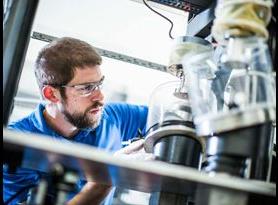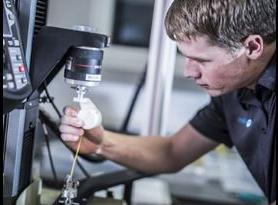Medical Device Testing Tips & Best Practices
Preparing for a medical device testing program can be a challenge for many manufacturers, especially if it is a new or novel product or if time is limited. How do you plan your testing programs? What is important to consider? What mistakes could be avoided on the front end? Our medical device experts share their testing tips and best practices.
Element routinely works with customers through various stages of the development cycle, some being first-time project managers while others are seasoned professionals. In many cases, the difference between a successful 510(k) submission and a failed one is preparation. The recommendations below can help you prepare for your upcoming test project, and save your company time and money.
Test sample availability
Maciej Jakucki – Medical Device Manager, Cincinnati, OH
Sending extra parts, if available, is critical. Parts can underperform, and if adequate samples are not available, it can result in costly setbacks both in time and money. When ordering parts, make sure to understand how many you’ll need for statistical significance, but also contingency planning. During feasibility testing or testing of a complex product, it is common to set up several devices first to ensure the test method is applicable and will generate the target results.
If a complex setup only has one chance to get it right, a necessary modification to the test setup can throw off the entire regulatory plan. The most successful projects often include additional parts for setup. If the parts are unused, extras can be used as additional points on an endurance curve, or to improve the statistical significance if variability was observed. Be careful not to assume that everything will pass your acceptance criteria – justifying the expense of an extra part compared to realizing you are behind 6 months is a risk worth mitigating. You waited all those months for your shiny parts to be delivered, you don’t want to have to wait that time again!
Test project timing and communication
Kristen Lipschultz – Department Manager, Minnetonka, MN
The early bird gets the worm! It’s always better to start discussions early to allow time for front-end development and feasibility work and to make sure the project is resourced appropriately to complete it on time (or even early!). Our most successful customers will call us to talk about potential setups or availability way in advance. We are dedicated to collaborating with your team to find the best testing solutions and mitigate risks with proactive planning strategies. Even if most of the details are still up in the air, it can be useful to include supporting teams in those early conversations to help steer the project towards the best path forward. Remember, too soon is always better than too late!
Also, come visit us! We enjoy working alongside our customers and learning about their companies and products. There is no better way to understand your product, test setup, and test results than to come on-site. Besides, breaking things is fun!
Brody Nelson – Project Engineer, Cincinnati, OH
When developing a new test method, talk to the test lab! We strive to be partners with our customers, not just a third-party vendor. We want to see your products succeed and improve patient lives. Including us in discussions regarding decisions and results helps us develop strong relationships and understand your goals and product line. It also makes it easier to work together the next time. The more we know, the more we can help. We see a lot of testing come through the lab and are involved in standards committees, understanding both existing common standards and new ones in development. It is surprising how many people try to do something that has already been developed or that there is a pre-existing consensus on how to run a test method. Also, we understand testing – so use that expertise to make the best decisions for your products, especially when considering a complex loading mechanism!
Communication of goals and timelines is vital to the success of your project. The sooner the lab knows about your timelines, the more ability we have to adjust and meet your requirements. Our adaptive scheduling can even decrease your overall project timeline, which is useful when there are delays, such as part manufacturing.
Test details and protocols
Andrew Smith M.S, PE – Business Development Manager, Washington DC
Pay attention to your embedding media. With epoxies, cement, and low-melt alloys, stiffness, shear strength, and UTS are all important. If the embedding media is too soft or weak, then the stresses can peak subsurface, where the part is intended to be constrained; if it is too stiff, then stress risers can form at the surface leading to premature failures. Materials can adhere differently or react (corrode, leach) in certain environments. As a result, they could be more difficult to remove after testing. It’s preferable to design the test so the peak stresses in the specimen occur away from the embedding interface, but may not always be possible.
Carlton Jones – Project Engineer, Minnetonka, MN
When determining the design requirements of a new product, it is useful to understand how the device will be tested to each specification. Often a singular test can be developed to incorporate multiple loading parameters (mechanical and/or electrical). This can help reduce test duration, prove a more rigorous, safe device, and accelerate time to market. Combining tests, however, does pose increased risks. It is most beneficial to start the test design early in the device development process. This allows for parallel path design of the device and test such that they will both be ready upon completion of the device design and the start of the formal regulatory testing. Informal feasibility testing provides shorter feedback loops on the device design and test setup and gives higher confidence in successful testing when performing formal testing, saving time and money.
Taylor Combs – Project Engineer, Cincinnati, OH
Working with the lab on a protocol is a valuable way to avoid delays and confusion once testing begins. Not only is this useful for completely custom projects which may not have a specific standard to reference, but also for more straightforward testing with even minor, unique modifications. By discussing the goals you hope to achieve through testing and going over the crucial information you would like to gain, we can help to develop a testing plan that does all of the above while avoiding overly complex or unfeasible setups. This way, once testing begins, both parties already know what to expect, which helps to minimize both obstacles and time spent on retroactive protocol adjustments. It also gives us an idea of how familiar your team is with testing, which can lead to a variety of additional questions or guidance.
Waylon Tran - Project Engineer, Minnetonka, MN
It is imperative that both sides understand the full scope of the project to set accurate expectations. It is helpful to know why you are testing so we can watch the results closely and report out as soon as possible. It is also helpful to highlight issues we have observed or to quickly flag details that aren’t aligned with the goals of the program. Sometimes, what is written in the protocol isn’t feasible or there is a better way to do it. If you are replicating internal test results, a previous test report and corresponding methodology can make a huge difference in aligning the data.
Data processing and reporting
Maciej Jakucki – Medical Device Manager, Cincinnati, OH
Graphs matter. Pay attention to the blips and dips in a graph and ask for clarification if not described, or take the time to understand the data and what it may mean for your product. Textbook force-displacement graphs are often expected in every case, and sometimes the data doesn’t align or is indicative of a quality issue which can be either product or setup related. This is especially true in multi-component testing where the same failure mode cannot be expected 100% of the time, and there will be variability. Every test engineer and technician strives for a perfect test result but can tell you that more often than not, the graph details point out other product behaviors.
Brody Nelson – Project Engineer, Cincinnati, OH
Reporting is a time-consuming process, and it helps ensure accuracy when details are confirmed before testing. Part numbers are one of the most common items that get changed. This can be for a variety of reasons but often can result in unnecessary revisions. Many of the specifications contain instructions to put the part descriptions so if the protocol leaves that information out or is generic, you will likely have to go back in and make an adjustment. Think through what description you will need and align it with the protocol to avoid unnecessary revisions.
The Element advantage
Element has developed internal processes to try to mitigate as many of these risks, and our ever-evolving quality system continues to adjust to be proactive and offer the best level of customer engagement we can. Taking the above comments into consideration can ensure a successful testing project and submission. We understand it may not be feasible to travel during some projects, but we always welcome our customers on-site and look forward to working alongside them.
If you have questions about your upcoming medical device testing projects, contact us. We’re happy to help.
Find related Resources
Related Services

Medical Device Testing
As a comprehensive testing partner, you’ll enjoy the benefit of a single supplier source for all of your testing needs, from mechanical testing and environmental simulation to EMC and wireless device testing.

Test Protocol for Medical Devices
A protocol and plan will mitigate your risk, prevent confusion, set clear expectations, and preserve the necessary information for future reference and use.

Evaluation Methods for 3D Printed Implants
Compared to traditional materials, additive manufactured materials require qualifying and validating of the powders, structures, individual printers and overall design, creating additional steps for characterization.

Gripping Medical Devices for Tensile Testing
Medical devices such as leads and sutures are typically subject to tensile testing to characterize their mechanical properties under tension. Gripping these devices during testing provides additional challenges and can require custom fixturing to obtain meaningful data.
